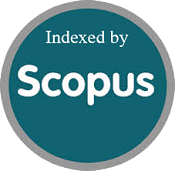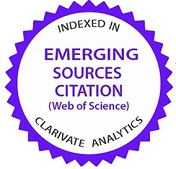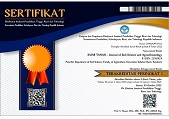Soil physico-chemical properties and microbial diversity on chilli anthracnose disease severity in Northern Karnataka, India
Abstract
Keywords
Full Text:
PDFReferences
Akhtar, N., Chandra, R., & Mazhar, Z. (2018). Influence of media, temperature and pH on growth of Colletotrichum capsici (Syd.) causing anthracnose disease of chilli. Journal of Pharmacognosy and Phytochemistry, 7(4), 3280-3284. https://www.phytojournal.com/archives/2018.v7.i4.5458/influence-of-media-temperature-and-ph-on-growth-of-ltemgtcolletotrichum-capsici-ltemgtsyd-causing-anthracnose-disease-of-chilli
Anaba, B. D., Yemefack, M., Abossolo-Angue, M., Ntsomboh-Ntsefong, G., Bilong, E. G., Ngando Ebongue, G. F., & Bell, J. M. (2020). Soil texture and watering impact on pot recovery of soil-stripped oil palm (Elaeis guineensis Jacq.) seedlings. Heliyon, 6(10), e05310. https://doi.org/10.1016/j.heliyon.2020.e05310
Das, S. K., Avasthe, R., Roy, A., & Singh, N. (2020). Soil sample analysis methods: A ready reckoner for soil testing. https://www.kiran.nic.in/pdf/publications/2020/Soil%20Sample%20Analysis%20Methods%20Shaon%20Kumar%20Das.pdf
De Silva, D. D., Ades, P. K., & Taylor, P. W. J. (2021). Pathogenicity of Colletotrichum species causing anthracnose of Capsicum in Asia. Plant Pathology, 70(4), 875-884. https://doi.org/https://doi.org/10.1111/ppa.13351
Devi, V., & Sumathy, V. J. H. (2017). Production of biofertilizer from fruit waste. European journal of pharmaceutical and medical research, 4(9), 436-443. https://www.ejpmr.com/home/abstract_id/2900
Elmer, W. H., & Datnoff, L. E. (2014). Mineral Nutrition and Suppression of Plant Disease. In N. K. Van Alfen (Ed.), Encyclopedia of Agriculture and Food Systems (pp. 231-244). Academic Press. https://doi.org/10.1016/B978-0-444-52512-3.00251-5
FAOSTAT. (2019). Production Data. http://faostat.fao.org/
Heck, D. W., Dita, M., Ponte, E. M. D., & Mizubuti, E. S. G. (2021). Incidence, Spatial Pattern and Temporal Progress of Fusarium Wilt of Bananas. Journal of Fungi, 7(8), 646. https://doi.org/10.3390/jof7080646
Indoria, A. K., Sharma, K. L., & Reddy, K. S. (2020). Chapter 18 - Hydraulic properties of soil under warming climate. In M. N. V. Prasad & M. Pietrzykowski (Eds.), Climate Change and Soil Interactions (pp. 473-508). Elsevier. https://doi.org/10.1016/B978-0-12-818032-7.00018-7
Jalgaonkar, K., Mahawar, M. K., & Vishwakarma, R. K. (2023). Destalking of dry red chillies (Capsicum annum L.) and its characterization. Journal of Food Science and Technology, 60(1), 404-418. https://doi.org/10.1007/s13197-022-05627-6
Jaskani, M. J., & Khan, I. A. (2021). Horticulture: An Overview. University of Agriculture Faisalabad, 3-22.
Jayaraman, S., Naorem, A. K., Lal, R., Dalal, R. C., Sinha, N. K., Patra, A. K., & Chaudhari, S. K. (2021). Disease-Suppressive Soils—Beyond Food Production: a Critical Review. Journal of Soil Science and Plant Nutrition, 21(2), 1437-1465. https://doi.org/10.1007/s42729-021-00451-x
Jisha, M. S., Linu, M., & Sreekumar, J. (2019). Induction of systemic resistance in chilli (Capsicum annuum L.) by Pseudomonas aeruginosa against anthracnose pathogen Colletotrichum capsici. Journal of Tropical Agriculture, 56.
Kabir, A. H., Baki, M. Z. I., Ahmed, B., & Mostofa, M. G. (2024). Current, faltering, and future strategies for advancing microbiome-assisted sustainable agriculture and environmental resilience. New Crops, 1, 100013. https://doi.org/10.1016/j.ncrops.2024.100013
Kalinowska, M., Samsonowicz, M., Świderski, G., Świsłocka, R., & Walery, M. (2021). Practical Analytical Techniques Used to Determine Selected Physicochemical Indicators of Water Quality. Agencja Wydawnicza Ekopress, Białystok. https://wb.pb.edu.pl/wp-content/uploads/2021/12/Skrypt-2-techniki-analityczne-ANG.pdf
Kommula, S. K., Reddy, G. P. D., Undrajavarapu, P., & Kanchana, K. S. (2017). Effect of Various Factors (Temperature, pH and Light Intensity) on Growth of Colletotrichum capsici Isolated from Infected Chilli. International Journal of Pure & Applied Bioscience, 5(6), 535-543. https://doi.org/10.18782/2320-7051.3071
Koralage, I. S. A., Weerasinghe, P., Silva, N. R. N., & De Silva, C. S. (2015). The determination of available phosphorus in soil: a quick and simple method. OUSL Journal, 8, 1-17.
Kumari, A., Mishra, P., Chaulya, S. K., Prasad, G. M., Nadeem, M., Kisku, V., . . . Chowdhury, A. (2024). Estimation of Soil Nutrients and Fertilizer Dosage Using Ion-Selective Electrodes for Efficient Soil Management. Communications in Soil Science and Plant Analysis, 55(13), 1920-1941. https://doi.org/10.1080/00103624.2024.2334255
Kundu, R., Adhikary, S., Padhan, D., Das, A., & Dutta, J. (2020). Extractable fractions of sulphur in major soils of India. Chemical Science Review and Letters, 9, 138-145. https://chesci.com/v9i33-cs2051017/
Mahapatra, B., Ghosh, D., & Mukhopadhyay, R. (2024). Biocontrol potential of Trichoderma and Pseudomonas: A review. International Journal of Advanced Biochemistry Research, 8(4S), 129–132. https://doi.org/10.33545/26174693.2024.v8.i4Sb.933
Malathi, G., Jegathambal, R., Kohila, P., & Vijayan, R. (2022). Assessment of per se performance of chilli (Capsicum annuum L.) hybrids TNAU Chilli Hybrid CO 1 and Arka Saanvi in Salem District of Tamil Nadu. Journal of Krishi Vigyan, 11(1), 433-435. https://doi.org/10.46647/ijetms.2023.v07i01.012
Marple, R. L., & LaCourse, W. R. (2019). Potentiometry: pH and Ion-Selective Electrodes. In N. Grinberg & S. Rodriguez (Eds.), Ewing's Analytical Instrumentation Handbook. CRC Press. https://doi.org/10.1201/9781315118024
Mongkolporn, O. (2019). Anthracnose disease in Capsicum. In Capsicum: Breeding Strategies for Anthracnose Resistance. CRC Press: Boca Raton, FL, USA. https://www.routledge.com/Capsicum-Breeding-Strategies-for-Anthracnose-Resistance/Mongkolporn/p/book/9781032095035?srsltid=AfmBOorHXg_X1eB-Fyd11eCe3ZdA99ro-2jk6XGO80jSK_01r3I3ZwV3
Mongkolporn, O., & Taylor, P. W. J. (2018). Chili anthracnose: Colletotrichum taxonomy and pathogenicity. Plant Pathology, 67(6), 1255-1263. https://doi.org/10.1111/ppa.12850
Moutassem, D., Belabid, L., Bellik, Y., Rouag, N., Abed, H., Ziouche, S., & Baali, F. (2019). Role of soil physicochemical and microbiological properties in the occurrence and severity of chickpea's Fusarium wilt disease. Eurasian Journal of Soil Science, 8(4), 304-312. https://doi.org/10.18393/ejss.585160
Naseri, B., & Ansari Hamadani, S. (2017). Characteristic agro-ecological features of soil populations of bean root rot pathogens. Rhizosphere, 3, 203-208. https://doi.org/10.1016/j.rhisph.2017.05.005
Nusyirwan, Afriani, L., & Perdana, R. (2022). Biplot analysis for mapping the soil sample characteristics of Rawa Jitu, Marga Tiga, and Teluk Ratai, Lampung Province. AIP Conference Proceedings, 2563(1). https://doi.org/10.1063/5.0115249
Pandey, P., Irulappan, V., Bagavathiannan, M. V., & Senthil-Kumar, M. (2017). Impact of Combined Abiotic and Biotic Stresses on Plant Growth and Avenues for Crop Improvement by Exploiting Physio-morphological Traits [Review]. Frontiers in Plant Science, 8. https://doi.org/10.3389/fpls.2017.00537
Rai, D., Fatehpuria, P. K., Kaurav, A. S., Singh, R., Sasode, H. T., & Sastry, P. (2020). Survey of anthracnose disease of chilli, Eastern Nimar region of Madhya Pradesh. International Journal of Chemical Studies, 8(2), 237-239. https://doi.org/10.22271/chemi.2020.v8.i2d.8775
Ramamoorthi, V., & Meena, S. k. (2018). Quantification of Soil Organic Carbon - Comparison of Wet Oxidation and Dry Combustion Methods. International Journal of Current Microbiology and Applied Sciences, 7(10), 146-154. https://doi.org/10.20546/ijcmas.2018.710.016
Rao, V. C. S., & Rao, G. V. K. (2014). An insight into chilli cultivation and risk management procedures with special reference to Karnataka and Andhra Pradesh. International Journal of Business and Administration, 2(3), 144-155. https://citeseerx.ist.psu.edu/document?repid=rep1&type=pdf&doi=7dcff9cec8baacf552bd4dc38a39d2d5e30113a5
Razaq, M., Zhang, P., Shen, H.-l., & Salahuddin. (2017). Influence of nitrogen and phosphorous on the growth and root morphology of Acer mono. PLOS ONE, 12(2), e0171321. https://doi.org/10.1371/journal.pone.0171321
Reddy, K. M. (2023). Capsicums for Nutrition and Entrepreneurship. In B. Singh & P. Kalia (Eds.), Vegetables for Nutrition and Entrepreneurship (pp. 297-309). Springer Nature Singapore. https://doi.org/10.1007/978-981-19-9016-8_14
Ridzuan, R., Rafii, M. Y., Ismail, S. I., Mohammad Yusoff, M., Miah, G., & Usman, M. (2018). Breeding for Anthracnose Disease Resistance in Chili: Progress and Prospects. International Journal of Molecular Sciences, 19(10), 3122. https://doi.org/10.3390/ijms19103122
Ruparelia, J., Rabari, A., Joshi, N., & Jha, C. K. (2022). Chapter 13 - Isolation methods for evaluation of extremophilic microbial diversity from Antarctica region. In A. Gunjal & S. Shinde (Eds.), Microbial Diversity in Hotspots (pp. 267-289). Academic Press. https://doi.org/10.1016/B978-0-323-90148-2.00008-0
Salotti, I., Ji, T., & Rossi, V. (2022). Temperature requirements of Colletotrichum spp. belonging to different clades [Original Research]. Frontiers in Plant Science, 13. https://doi.org/10.3389/fpls.2022.953760
Sangeetha, J., & Thangadurai, D. (2013). Staining Techniques and Biochemical Methods for the Identification of Fungi. In V. K. Gupta, M. G. Tuohy, M. Ayyachamy, K. M. Turner, & A. O’Donovan (Eds.), Laboratory Protocols in Fungal Biology: Current Methods in Fungal Biology (pp. 237-257). Springer New York. https://doi.org/10.1007/978-1-4614-2356-0_19
Saxena, A., Raghuwanshi, R., Gupta, V. K., & Singh, H. B. (2016). Chilli Anthracnose: The Epidemiology and Management [Review]. Frontiers in Microbiology, 7. https://doi.org/10.3389/fmicb.2016.01527
Sembiring, M., Hutahuruk, J. M., Susilowati, D. N., Yuniarti, E., Sabrina, T., & Siregar, L. A. M. (2024). Functional diversity of bacteria in various saline soil plant vegetations around Sialang Buah Coast, North Sumatra, Indonesia. Sains Tanah Journal of Soil Science and Agroclimatology, 21(2), 9. https://doi.org/10.20961/stjssa.v21i2.80075
Setiawati, M. R., Afrilandha, N., Hindersah, R., Suryatmana, P., Fitriatin, B. N., & Kamaluddin, N. N. (2023). The effect of beneficial microorganism as biofertilizer application in hydroponic-grown tomato. Sains Tanah Journal of Soil Science and Agroclimatology, 20(1), 12. https://doi.org/10.20961/stjssa.v20i1.63877
Sharma, U., & Kumar, P. (2016). Micronutrient Research in India: Extent of deficiency, crop responses and future challenges. International Journal of Advanced Research, 4(4), 1402-1406. https://doi.org/10.21474/ijar01/234
Shekhar, M., & Singh, N. (2021). The Impact of Climate Change on Changing Pattern of Maize Diseases in Indian Subcontinent: A Review. In M. A. El-Esawi (Ed.), Maize Genetic Resources - Breeding Strategies and Recent Advances. IntechOpen. https://doi.org/10.5772/intechopen.101053
Shen, Z., Ruan, Y., Xue, C., Zhong, S., Li, R., & Shen, Q. (2015). Soils naturally suppressive to banana Fusarium wilt disease harbor unique bacterial communities. Plant and Soil, 393(1), 21-33. https://doi.org/10.1007/s11104-015-2474-9
Shoaib, A., Akhtar, M., Javaid, A., Ali, H., Nisar, Z., & Javed, S. (2021). Antifungal potential of zinc against leaf spot disease in chili pepper caused by Alternaria alternata. Physiology and Molecular Biology of Plants, 27(6), 1361-1376. https://doi.org/10.1007/s12298-021-01004-3
Silva Souza, L. C., Guimarães Assis, L. A., Catarino, A. d. M., & Hanada, R. E. (2020). Screening of chilli pepper genotypes against anthracnose (Colletotrichum brevisporum). Emirates Journal of Food and Agriculture, 31(12), 919-929. https://doi.org/10.9755/ejfa.2019.v31.i12.2039
Singh, S. R., Ao, N. T., Devi, H. M., Singh, S. H., Debbarma, S., Daiho, L., & Devi, H. S. (2022). Efficacy of Different Levels of NPK against Anthracnose of King Chilli (Capsicum chinense) Caused by Colletotrichum gloeosporioides (Penz.) and Impact on Their Growth Parameters and Yield in Manipur. International Journal of Environment and Climate Change, 12(12), 637-647. https://doi.org/10.9734/ijecc/2022/v12i121501
Smagin, A. V., Sadovnikova, N. B., Prokopyeva, K. O., Kalnin, T. G., & Mamutov, N. K. (2024). Methodological Problems of Assessing the Salinatization of Arid Soils by the Electrical Conductivity of the Liquid Phase. Arid Ecosystems, 14(1), 25-36. https://doi.org/10.1134/S2079096124010141
Suntoro, Herdiansyah, G., & Mujiyo. (2024). Nutrient status and soil fertility index as a basis for sustainable rice field management in Madiun Regency, Indonesia. Sains Tanah Journal of Soil Science and Agroclimatology, 21(1), 10. https://doi.org/10.20961/stjssa.v21i1.73845
Sutin Raj, T., Christopher, D. J., & Ann Suji, H. (2014). Efficacy of Pseudomonas fluorescens on control of chilli fruit rot caused by Colletotrichum capsici. African Journal of Microbiology Research, 8(29), 2772-2777. https://doi.org/10.5897/AJMR2013.6567
Udhayakumar, R. (2018). Influence of different temperature and relative humidity levels on the mycelial growth, conidial germination and anthracnose incidence of Colletotrichum gloeosporioides. Innovations in Agriculture, 1. https://doi.org/10.25081/ia.2018.v1.i2.1031
Villa-Rivera, M. G., & Ochoa-Alejo, N. (2020). Chili Pepper Carotenoids: Nutraceutical Properties and Mechanisms of Action. Molecules, 25(23), 5573. https://doi.org/10.3390/molecules25235573
Wang, C., & Kuzyakov, Y. (2024). Soil organic matter priming: The pH effects. Global Change Biology, 30(6), e17349. https://doi.org/10.1111/gcb.17349
Yadav, P., Singh, D., & Bahadur, V. (2024). Genetic Variability and Correlation Studies in Chilli (Capsicum annuum L.) Under Agro-Climatic Condition of Prayagraj. International Journal of Plant & Soil Science, 36(6), 533-539. https://doi.org/10.9734/ijpss/2024/v36i64655
Zhang, X., Dong, K., Hao, B., Ding, M., Zuo, S., Wang, R., & Li, R. (2024). Potassium Permanganate/Persulfate Combined Oxidation Remediation of Petroleum Contaminated Soil. Water, Air, & Soil Pollution, 235(6), 393. https://doi.org/10.1007/s11270-024-07217-y
Refbacks
- There are currently no refbacks.











.png)





